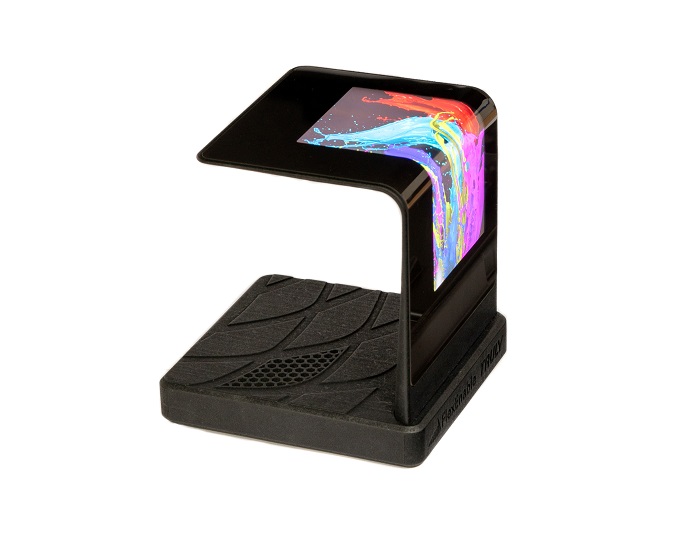By James Harding, system design manager, FlexEnable
Liquid crystal display (LCD) panels are a mature and ubiquitous technology. However, their rigid glass-based construction has, until now, made them a compromised solution for many new applications. Recent breakthroughs in materials have allowed the development of transistors based on organic semiconductors. These organic LCDs (OLCDs) can be manufactured on plastic substrates, offering more possibilities than a flat display with the ability to be curved around a tight radius or cut to unusual shapes, with the additional benefits of being shatterproof and lightweight.
Here we discuss the potential advantages of OLCDs for a range of industries, from consumer goods to automotive and aerospace.
More than two decades after its widespread adoption, LCD technology still accounts for over 90 percent of screens sold today. As alternative display technologies have emerged, LCDs have had to become thinner and lighter while, at the same time, offering considerable increases in screen size, resolution, color, contrast, brightness, and refresh rate. Despite these developments, the rigid glass-based construction of LCDs still puts design constraints on many new applications and products.
Flexible OLED is now commonly used in flagship smartphones and watches and, until recently, has been the only conformable alternative, offering curves with a radius of a few millimeters. However, the recent development of OLCDs has opened up a whole new dimension of design freedom to the wider display market. Based on exactly the same tried-and-tested principles as glass/silicon-based LCDs, OLCDs use organic rather than amorphous silicon transistors. The much lower temperatures required for the production of these organic transistors allow the use of flexible plastic substrates. This means that they are ultra-thin, lightweight, and shatterproof.
The ability to work with plastic rather than glass removes the traditional design constraints associated with LCDs, and offers the chance to create unique display shapes and curves, thanks to the ease of cutting plastic. Plastic OLCDs can also be easily shaped into convex or concave screens with tight curves down to a radius of 10 mm, without compromising the robustness of the display.

Organic LCD with a 10-mm bend radius. (Image: FlexEnable)
The use of organic TFTs allows the entire OLCD manufacturing process to be kept below 100°C, as they do not require the energy-intensive steps associated with silicon-based LCDs. This reduces the process energy requirements by a factor of 10 by some estimates. It also opens up a whole new class of low-cost plastics for use as substrates, such as cellulose triacetate (TAC), an optically ideal plastic already used in polarizers for LCDs. Together with the significant weight savings on offer — OTFTs are four times thinner and up to 10 times lighter than conventional glass-based TFTs — this makes OLCD a logical choice for manufacturers who are looking for a route to large flexible displays without a price tag to match.
One sector that stands to gain a lot from being an early adopter of OLCDs is the automotive industry. In many cars, the only remaining flat surface is the navigation or infotainment system, while every other surface is curved. Adopting OLCDs will allow larger displays to be integrated into the curved dashboards and center consoles, improving visibility without sacrificing passenger space.
The recently unveiled Novares Nova Car #2 is a good example of this, with twin 12.1” OLCDs integrated into the S-shaped central touchscreen, as well as 4.68” concave OLCDs to replace the side mirrors. The weight savings offered by this technology could also have knock-on benefits in terms of fuel savings, helping to save money and reduce the environmental impact of travel.
This is even more important for the aviation sector, where it costs between $250-$500 in fuel for every extra kilogram of mass transported throughout a year. If you consider the combined weight of all the in-flight entertainment displays in your average airplane, switching to OLCDs could deliver significant savings with every single flight!

Novares has demonstrated side view mirror replacements using flexible OLCD technology. (Image: Novares)
LCD has a fascinating resilience; it has reinvented itself many times, and OLCD is the next chapter in that story. The incredible versatility afforded by OLCDs enables curved and conformed displays of all shapes and sizes to be used in ways that have never been possible with traditional glass displays.
The next steps will be to create borderless OLCDs for notebooks, tablets, monitors and TVs, as well as dual-cell OLCDs for the ultra-high contrast applications currently dominated by high cost OLED technologies. Whatever happens in the next 20 years, product designers now have their work cut out for them as they begin to design with OLCDs, and we can expect to see wrappable and curved screens in many applications where glass displays are used today.
About the author:
Dr James Harding is the manager for the system design team at FlexEnable. He has over 15 years of experience in the organic electronics industry. James joined FlexEnable after completing his Ph.D. on the physics of organic semiconductors at Imperial College, having previously worked at Hewlett Packard Labs in Bristol, UK and Osram Opto Semiconductor in California. James has also been awarded the 2018 Ben Sturgeon award by the SID UK & Ireland chapter in relation to the development of OLCD. This award is given to individuals who have made a significant contribution to the development of displays.
Advertisement
Learn more about Electronic Products Magazine





